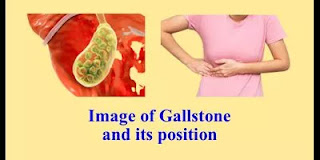What is Cholelithiasis?
The gallbladder is located on the right side of the abdomen, below the liver. The main function of the gallbladder is to store concentrated bile produced by the liver. Gallstones form in the gallbladder and are pieces of stone/solid material. Stones form when pigments and cholesterol mix in bile, causing blockage and pain in the bile duct. Stones and polyps form when the gallbladder wall is infected...
Causes of Cholelithiasis:
The main cause of gallstones is cholesterol! According to Healthline, about 85% of gallstones are caused by the accumulation of fat that leads to cholesterol. Other causes are the accumulation of calcium salts, which leads to the gall bladder.
Cholesterol in the bile: Too much accumulation of cholesterol in the bile can lead to yellow-colored stones. The function of bile is to dissolve stones. However, if fat builds up in your liver, it leads to cholesterol, and because the bile can't dissolve it, it leads to stone formation.
Bilirubin in Bile: Bilirubin is produced in your body when your liver destroys old red blood cells. In some cases, such as liver damage or certain blood disorders, the liver produces more bilirubin than it should. Thus overloading the gallbladder with minerals. Pigment gallstones form when the gallbladder is unable to break down bilirubin produced in excess. This is how they form black or dark brown stones.
Concentrated bile causing a full gallbladder: The gallbladder empties bile to stay healthy. However, when it fails, the bile contents become over-concentrated and lead to the formation of stones.
Gallbladder Stones: Symptoms
Gallbladder pain usually occurs in the upper right part of the abdomen. The pain is triggered by eating food with a high fat content - such as meat or fried food. The pain lasts for several hours. Gallstones often do not show any serious symptoms. However, if they get stuck in the pipe, it can cause a blockage. In such cases, you may experience one or more of the symptoms below:
- Occasional acute pain in the upper right part of the abdomen
- Burping
- Dark urine
- Diarrhea
- Indigestion/acidity
- Nausea
- Vomiting
Apart from the above symptoms, there is no pain with an asymptomatic gallstone, but occasional pain is there when the gallstone blocks the movement of bile from the gallbladder.
Risk in the Cholelithiasis:
If any of the above symptoms last for more than 2 hours, the gallstone will block the duct and cause infection and inflammation. This condition is known as acute cholecystitis. Although the probability of this happening is only 1-3%, it is best not to delay it and see a doctor as soon as possible. Symptoms include:
- Fever
- Loss of appetite
- Chills
- Intense pain in the upper abdomen
- Nausea and vomiting
Diagnosis of Cholelithiasis:
For diagnostics, we proceed according to the following steps:
Examination
A physical examination performed helps in identifying the early symptoms of gallstones. This includes - checking the eyes and skin color, as a yellowish tint may indicate symptoms of jaundice.
Ultrasound
Ultrasound helps in visual identification of gallstones and underlying abnormalities. Also, if there is any additional complexity involved.
Abdominal CT scan
An imaging test done to identify abnormalities in the liver and abdomen through images.
Radionuclide scan of the gallbladder
An accurate test that actually identifies a gallstone. A radioactive substance is introduced through the patient's veins, which moves from the gallbladder and liver through the blood. It accurately identifies whether there is a blockage of the bile ducts and the infection is from a stone.
Blood test
A blood test is done to measure the amount of bilirubin in the blood. While it determines the toxin content in your blood, it also tests how well your liver is working.
Endoscopic retrograde cholangiopancreatography
Gallbladder problems are primarily associated with the duct. Endoscopic retrograde cholangiopancreatography uses a camera and X-ray to get deep into problems in the bile and pancreatic ducts.


Post a Comment